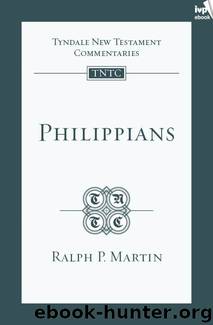Philippians (TNTC) by Ralph P. Martin

Author:Ralph P. Martin [Martin, Ralph P.]
Language: eng
Format: epub
ISBN: 9780830842414
Barnesnoble:
Publisher: InterVarsity Press
Published: 2008-11-09T16:00:00+00:00
Later discussion has suggested a modification of this arrangement, but at the cost of removing certain phrases from the text in the interest of metrical harmony. Jeremias’ reconstruction emphasizes the three aspects of our Lord’s existence, viz. his pre-existence, incarnate life and exalted status as Lord, by his arrangement into three stanzas as follows. Stanza I comprises verses 6 and 7a; stanza II, verses 7b and 8; stanza III, verses 9–11. But this requires the excision of some phrases (‘in heaven and on earth and under the earth’, ‘to the glory of God the Father’ as well as ‘even death on a cross’) in order to achieve the result of a perfectly balanced hymn. If that is an achievable goal and not a will-o’-the-wisp, as Hawthorne thinks, a setting down of these verses to form a series of antiphonal lines in couplets is possible.27
On the matter of background there is a wide variety of interpretation. Continental scholars, especially those who ‘demythologize’ the New Testament, see the hymn against the background of Hellenistic or gnostic notions of a ‘heavenly man’ who descended to earth and carried through a mission of redemption for humankind.28 The influence of this theory on the outlook of the apostle must be seriously questioned in spite of certain formal resemblances between the myth and the terms which he uses to express his understanding of Christ.
The Old Testament, we believe, provides the most intelligible background to these verses (so Caird, Getty, Bruce, Hawthorne). The two concepts which are most likely to underlie the apostle’s thought are the teaching concerning Adam, and the notion of wisdom as developed from Proverbs 8 by the inter-testamental writers (Sirach 24; Wisdom of Solomon ch. 2–7). His existence in the divine form as God’s image patterned on wisdom’s role, and his refusal to grasp at equality with his Father find their parallel in the story of the first man and his temptation. The obedience, humiliation and exaltation of the Lord are also foreshadowed in the picture of the Suffering Servant of Isaiah 52–53. It is this fusion of ideas, under the directing Spirit of God, which gave to the early Christian community in Syria and Antioch, and, it may be, through the infant church especially in the school of Stephen,29 to the apostle himself, this noble presentation. It is the record of the pre-existent, humiliated and glorified Lord who is ever the object of the church’s worship and the destined Ruler of all created life.
Download
This site does not store any files on its server. We only index and link to content provided by other sites. Please contact the content providers to delete copyright contents if any and email us, we'll remove relevant links or contents immediately.
| New Testament | Old Testament |
The Five People You Meet in Heaven by Mitch Albom(3473)
The Secret Power of Speaking God's Word by Joyce Meyer(2966)
Real Sex by Lauren F. Winner(2965)
Name Book, The: Over 10,000 Names--Their Meanings, Origins, and Spiritual Significance by Astoria Dorothy(2938)
The Holy Spirit by Billy Graham(2892)
0041152001443424520 .pdf by Unknown(2783)
ESV Study Bible by Crossway(2732)
How The Mind Works by Steven Pinker(2728)
Ancient Worlds by Michael Scott(2622)
Churchill by Paul Johnson(2505)
The Meaning of the Library by unknow(2503)
The ESV Study Bible by Crossway Bibles(2502)
The Gnostic Gospels by Pagels Elaine(2468)
MOSES THE EGYPTIAN by Jan Assmann(2372)
Jesus by Paul Johnson(2309)
City of Stairs by Robert Jackson Bennett(2307)
The Complete Dead Sea Scrolls in English (7th Edition) (Penguin Classics) by Geza Vermes(2231)
Ancient Near Eastern Thought and the Old Testament by John H. Walton(2194)
The Nativity by Geza Vermes(2178)
